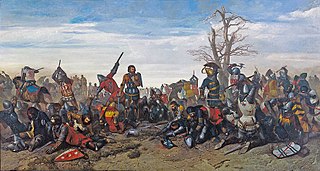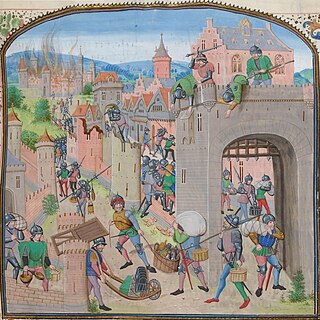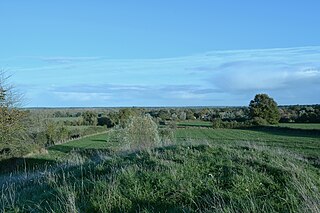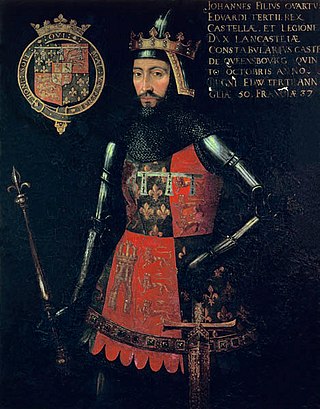Related Research Articles

The House of Bourbon is a dynasty that originated in the Kingdom of France and is a branch of the Capetian dynasty, the royal House of France. Bourbon kings first ruled France and Navarre in the 16th century, and by the 18th century, members of the Spanish Bourbon dynasty held thrones in Spain, Naples, Sicily, and Parma. Today Spain and Luxembourg have monarchs of the House of Bourbon. The royal Bourbons originated in 1272, when Robert, the youngest son of King Louis IX of France, married the heiress of the lordship of Bourbon. The house continued for three centuries as a cadet branch, serving as nobles under the direct Capetian and Valois kings.

Joanna of Bourbon was Queen of France by marriage to King Charles V. She acted as his political adviser and was appointed potential regent in case of a minor regency.

The Combat of the Thirty, occurring on 26 March 1351, was an episode in the Breton War of Succession fought to determine who would rule the Duchy of Brittany. It was an arranged fight between selected combatants from both sides of the conflict, fought at a site midway between the Breton castles of Josselin and Ploërmel among 30 champions, knights, and squires on each side. The challenge was issued by Jean de Beaumanoir, a captain of Charles of Blois supported by King Philip VI of France, to Robert Bemborough, a captain of Jean de Montfort supported by Edward III of England.

The Battle of Nájera, also known as the Battle of Navarrete, was fought on 3 April 1367 to the northeast of Nájera, in the province of La Rioja, Castile. It was an episode of the first Castilian Civil War which confronted King Peter of Castile with his half-brother Count Henry of Trastámara who aspired to the throne; the war involved Castile in the Hundred Years' War. Castilian naval power, far superior to that of France or England, encouraged the two polities to take sides in the civil war, to gain control over the Castilian fleet.

Marie de Berry was suo jure Duchess of Auvergne and Countess of Montpensier in 1416–1434. She was the daughter of John, Duke of Berry, and Joanna of Armagnac. She was married three times. She acted as administrator of the Duchy of Bourbon for her third spouse John I, Duke of Bourbon, during his imprisonment in England after he was captured following the French defeat at the Battle of Agincourt in 1415, until 1434.

The House of Bourbon-Montpensier or Maison de Bourbon-Montpensier was a semi royal family. The name of Bourbon comes from a marriage between Marie de Valois, comtesse de Montpensier (1375–1434) who married Jean de Bourbon - the duc de Bourbon. The second name of Montpensier, comes from the title of the family.

The Bal des Ardents or the Bal des Sauvages, was a masquerade ball held on 28 January 1393 in Paris at which Charles VI of France performed in a dance with five members of the French nobility. Four of the dancers were killed in a fire caused by a torch brought in by Charles's brother Louis I, Duke of Orléans.
Tard-Venus were medieval groups of routiers that ravaged Europe in the later years of the reign of King John II of France.

Hagre l'Escot was a Scottish mercenary captain during the Hundred Years War.

Francois Hennequin, was a mercenary captain during the Hundred Years War.

Naudon de Bageran was a mercenary captain during the Hundred Years War.

Robert Birkhead (Briquet) was a mercenary captain during the Hundred Years War.

John Creswey was an English mercenary captain during the Hundred Years War.

Aymon of Ortinge, also known as Amanieu d'Ortigue or Amanieu de l'Artigue, was a French mercenary captain during the Hundred Years' War. His story is mentioned in the Chronicles of Froissart.

Bernard de la Salle, was a French mercenary captain during the Hundred Years War. His story is mentioned in the Chronicles of Froissart.

Belleperche was a castle, now destroyed, located in the current town of Bagneux (Allier). It was the seat of one of the castellany of Bourbonnais.

Bour de Breteuil was a mercenary captain of the Hundred Years War.

Bour Camus, or Camus Bour Lesparre, also known as Camus the Bastard was a mercenary captain during the Hundred Years War. He was of Navarrese or Gascon origin.

John of Gaunt's chevauchée of 1373 was an English military raid at the end of the second period of the Hundred Years' War by John of Gaunt, Duke of Lancaster, from his departure from Calais in August 1373 to his arrival at Bordeaux at the end of December 1373.
References
- ↑ Jean Alexandre C. Buchon, Charles Du Fresne Du Cange (sieur), Georges Chastellain, Geoffroi de Villehardouin, Enguerrand de Monstrelet, Jean Froissart, Jean Molinet, Geoffroi de Paris, Collection des chroniques nationales françaises, Volume 14(Verdière & J. Carez, 1824) p124
- ↑ Charles Du Fresne Du Cange (sieur), Histoire de l'empire de Constantinople sous les empereurs français jusqu'à. (Verdière, 1824), p124.
- ↑ Jean Froissart, Chronicles of England, France, Spain, and the Adjoining Countries: From the Latter Part of the Reign of Edward II. to the Coronation of Henry IV. (W. Smith, 1839) p440.